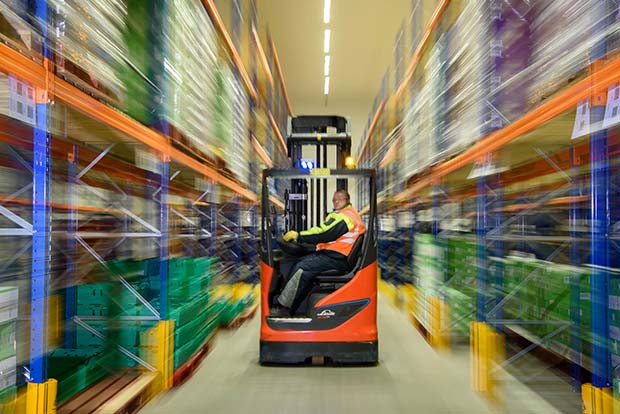David Bowen, Product Manager for Warehouse Trucks at Linde Material Handling UK discusses the future of energy solutions for forklifts.
 “Energy systems are a key focus for us at Linde. We’re working to use the latest innovations in energy to help power the logistics industry in faster, more efficient and cleaner ways.
“Energy systems are a key focus for us at Linde. We’re working to use the latest innovations in energy to help power the logistics industry in faster, more efficient and cleaner ways.
“It’s important to know about all the options available when purchasing or renting a forklift, as different types of energy have different advantages depending on truck use.
“Many of our customers are moving away from IC engines in favour of electrically-powered trucks and warehouse equipment. But as technology advances, they are faced with an increasing number of options.
Lead acid batteries
“The classic choice for electric powered trucks is lead-acid batteries. “It is well known and well established and remains the most frequently used technology by our customers.
“Thanks to developments in charging technology, battery chemistry, management, and changing systems, they are still an attractive option – despite some compromises.
“These include changing batteries in multi-shift applications, and measures for battery care and limited battery life.
“However, for businesses using their trucks less frequently or for light duties, lead-acid battery trucks remain cost-effective.
Lithium-ion batteries
“Lithium-ion technology has become a common power source in recent years extending into electric or hybrid cars and power tools.
“Since we announced our trucks up to five tonnes lifting capacity would be available with lithium-ion batteries, many of our customers switched to more environmentally-friendly lithium-ion power due to the numerous advantages.
“These include higher energy density, rapid charging, more consistent performance, longer battery life and low maintenance requirements.
“The high level of energy stored in the batteries results in longer shift life between charges whilst fast opportunity charging maintains battery energy at a high level and the main advantage is batteries can be charged anytime.
“This eliminates spare batteries and battery changing equipment, reducing costs and the health and safety overhead attached to handling leadacid batteries.
“It takes around 50 minutes to charge a small lithium-ion battery with a fast charger which is useful for sites which have a short rest period between operations.
“Lithium-ion batteries don’t release dangerous gases when charging and, unlike others, the Lithium-ion chemistries used by Linde are able to operate in very low temperatures, ideal for cold stores.
“Linde guarantees the batteries will retain at least 80% of their original capacity after more than 2,500 full charging cycles, making lithium-ion drive technology a cost-effective solution for customers.
“Our lithium-ion trucks, batteries and chargers communicate using Linde ‘Connect:’ which fleet managers and aftersales service personnel can use to check the status of the fleet.
“Overall performance can be optimised as warehouse managers can check when trucks require a safety check or a routine service, ensuring trucks are using their energy in the most efficient way.
“Safety is a concern to any warehouse manager, which is why we install our lithium-ion cells in a 25mm thick steel battery box to withstand even the most violent crash situations without damage to the cells.
“We have developed a software tool which shows the cost-effectiveness of the technology by recommending the optimum combination of battery size and charger for each specific application, and how much money will be saved by moving to lithium-ion trucks.
“Our research and development into lithium-ion technology demonstrates our commitment to providing efficient and environmentally-friendly technologies.
Fuel cell
“This year, at our World of Material Handling exhibition, we presented a prototype reach truck which can be refuelled in under five minutes. This makes fuel cell technology a real alternative in multi-shift operations.
“The hydrogen fuel cell combines hydrogen with oxygen from the air to provide electrical energy. The only emission is pure water making its operation environmentally-friendly.
“At present this technology is not economically viable in most cases and the environmental credentials can vary depending on the source of the hydrogen and how it’s delivered to site.
Engine trucks
“While battery-based power sources are becoming increasingly popular, traditional engine trucks are still a common choice.
“We have worked hard to develop energy-efficient and environmentallyfriendly ways of powering enginebased trucks, including hydrostatic power.
“Linde’s counterbalance trucks can save a significant amount of fuel with hydrostatic drive technology built into the engines. The trucks have fewer moving mechanical parts meaning power loss between the engine and trucks wheels is decreased, lowering fuel consumption and reducing carbon emissions.
“So which energy source should you choose? Is there a clear choice? It all depends on your logistics requirements.
“While lithium-ion batteries are suitable for applications involving constant truck use, where there is no time to provide opportunity charging, classic lead-acid batteries remain the best option.
“The logistics industry is changing rapidly and innovating thanks to new energy sources becoming available.
“The future looks set to discover new ways of improving efficiency, reducing downtime, improving intralogistics and becoming more environmentally friendly.”




Comments are closed.